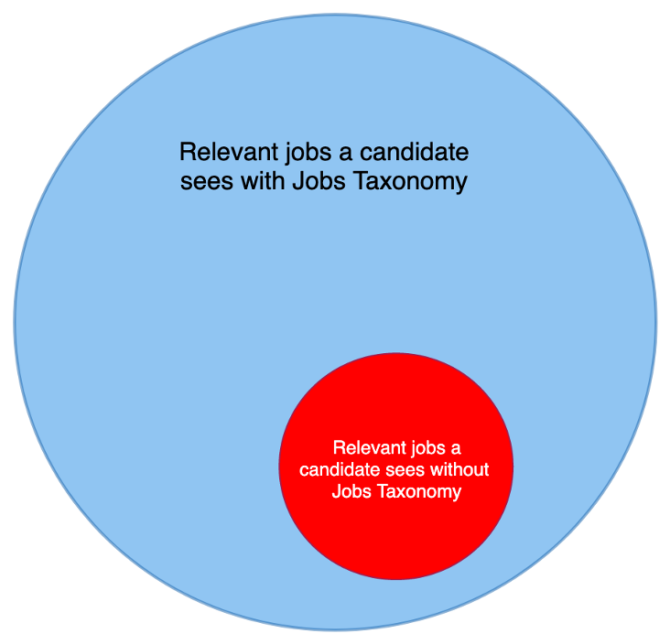Job taxonomy
Jobs Taxonomy is a service that analyzes, organizes and enhances job listings to ensure job seekers can easily find relevant jobs. It’s also the reason why candidates who search for “sales representative” roles can find other relevant listings even when those listings use different language (like “business development representative”). If you attract a candidate to your job board or platform, you want to make sure you help them find relevant listings and that’s what the Jobs Taxonomy tool accomplishes.
What exactly is Jobs Taxonomy?
Put simply, Jobs Taxonomy is a service that lets you ensure every listing on your job board is organized logically and accurately. This accuracy benefits everyone. But before digging into why Jobs Taxonomy benefits users, let’s dig into the “how.”
When scraping jobs to build out a job board, there’s always a source (like a careers page or ATS) and a target (the job board itself).
Most sources and targets have categories they use to organize the job listings. These categories may be related to industry, function (sales, marketing, IT, etc.), title (specialist, manager, director, etc.), and more.
Here’s the heart of Jobs Taxonomy: when parsing job listings, every category from the source must be mapped to a category from the target.

Figure 1: The category breakdown for a sales manager role based in Florida.
If a target and a job board use the same categories to organize job listings, mapping is fairly easy. But this is NOT typically the case, and complications can arise in different cases, like these two:
What if a source and target use different categories?
For instance, say the ATS maps finance and accounting roles together under the category “Finance and Accounting” but your job board lists Finance and Accounting roles separately.
What if a source doesn’t use categories?
Say you’re extracting sales jobs from an organization’s “careers” page. Every listed position is a sales position, but it isn’t categorized or listed as such. Effectively, you’re scraping listings with titles like “Director” or “Manager” without the qualifier that they’re sales roles.
In both cases, Jobs Taxonomy lets you align the categories between your source and your target by creating logic for tagging jobs.
For example, in our first case, Jobs Taxonomy would let you designate which source categories align with your target categories. And in the second case, Jobs Taxonomy would let you designate that all jobs from a given source – in this example, a sales organization – should be put in a certain category (“Sales”).
How does Jobs Taxonomy benefit job boards, employers, and job seekers?
There are a few key ways Jobs Taxonomy improves the job search experience for job seekers and job boards.
1. Job Taxonomy offers more relevant data to job seekers
Job alerts are one of the best ways candidates can stay informed about open positions that fit their skills and interests. But job seekers likely aren’t thinking about the way a job board uses categories. That means they’re also probably not creating individual job alerts for titles similar to the one they’re targeting; i.e., someone who creates a job alert for “transportation manager” likely won’t also create one for “transportation supervisor” or “head of transportation.” Jobs Taxonomy ensures that candidates see all relevant listings when creating job alerts or searching for specific roles.
It’s a bit like the part of the Google search algorithm that lets searchers see relevant results even if they don’t include an exact-match keyword.
2. Jobs Taxonomy improves the user experience of your job board
When candidates can easily search for and view listings, it reduces the odds they’ll leave your job board before they complete an application. That has the downstream effect of increasing the number of clicks or applications that listings receive, which, in turn, leads to more applications and compels employers to use your job board in their recruiting efforts.
3. Jobs Taxonomy widens the candidate pool
Just as Jobs Taxonomy ensures job seekers see all relevant positions, it also helps employers find all qualified candidates – even those who may be searching for a title that doesn’t exactly match their listing.
This means employers can post their jobs and ensure their entire target audience sees them.

Figure 3: Jobs Taxonomy helps ensure job seekers see a greater number of relevant positions that employers advertise.
How does Jobs Taxonomy work for job boards?
We currently offer two Jobs Taxonomy options: generic and custom. You can either bundle Jobs Taxonomy services with job scraping or request Jobs Taxonomy as a standalone service.

Figure 2: WebSpiderMount scrapes and refines jobs data – from source to target.
We also have a mapping tool for customers who want to use Jobs Taxonomy and manage the mapping themselves. This is an attractive option for those who need thousands of custom categories and rules and don’t want to pay for our team to maintain the system on an ongoing basis. But, remember, once you setup a mapping, the system will automatically map all future postings. Many customers start with a couple hundred mappings and just add more as needed. It isn’t cumbersome, and the mappings improve over time.
With this option, you tell us which categories and subcategories you’d like as well as which types of jobs go into those categories and subcategories. We set up rules based on this information; then we teach you how to use the mapping tool and offer guidance along the way. But we let you oversee the job listings and map them accordingly.
Interested in learning more about Jobs Taxonomy? Reach out here for a quote or clarification.